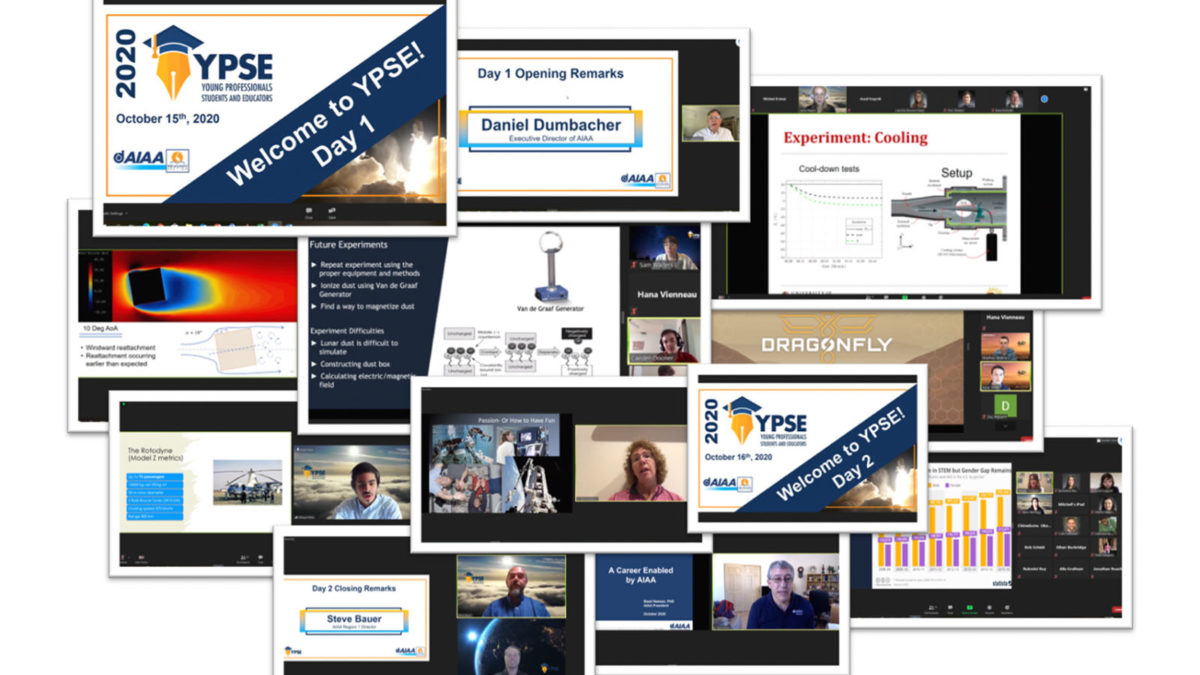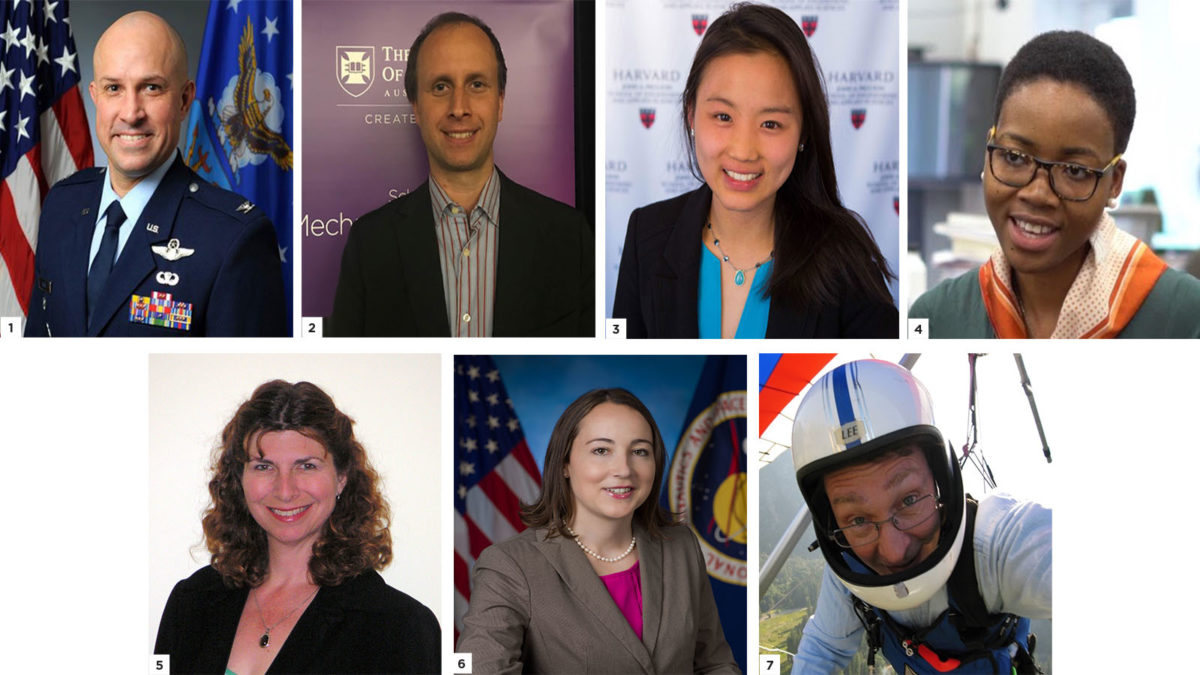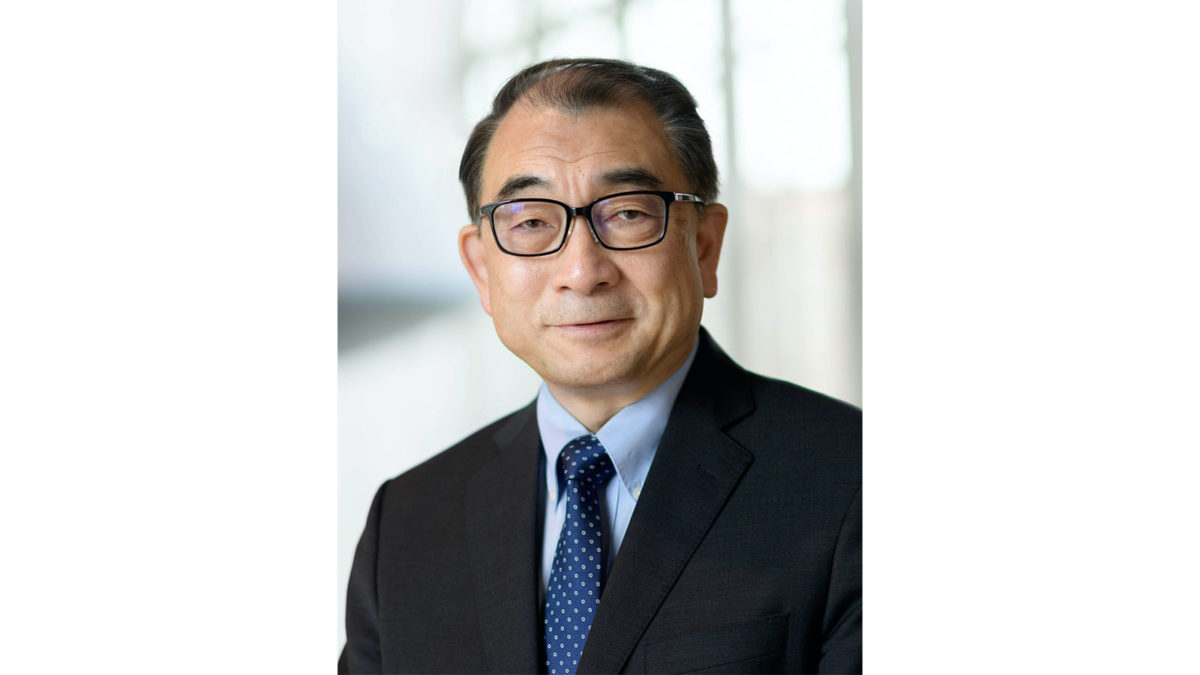- 2021 AIAA Sustained Service Award Winners Announced
- Young Professionals, Students, and Educator Conference Held Virtually in October
- Making an Impact: Aerospace Career Pathways: AIAA Student Webinar Series
- AIAA Sydney Section Student Conference/Region VII Student Conference Held in November
- Dr. Tom I-P. Shih Appointed as New Editor-In-Chief of the AIAA Journal
- AIAA Fellow Weiss Died in March
- AIAA Senior Member Sharples Died in November
- AIAA Honorary Fellow Teets Died in November
Bulletin
Award Announcements 2021 AIAA Sustained Service Award Winners Announced
AIAA is pleased to announce the winners of the 2021 Sustained Service Awards, which recognize sustained, significant service and contributions to AIAA by members of the Institute.
Willem A. Anemaat
DARcorporation
For your extensive service to AIAA through your work on technical committees, national awards, publications, and conferences.
Kevin Burns
American Legion
For sustained and dedicated service to the AIAA History Committee, San Diego Section, Niagara Frontier Section, AIAA conferences/forums, and decades of mentorship to students from universities across the country.
Terry J. Burress
Lockheed Martin Aeronautics
For continuous and exemplary service to the AIAA South Central Region and the Modeling and Simulation Technical Committee, including strengthening the membership and the technical excellence of the Institute and its committees in both formal and informal leadership roles.
Dean Earl Davis
For his 46 years of active AIAA contributions from college chairman to LA-LV Section and STEAM chairman.
Jeanette L. Domber
Ball Aerospace
Honoring over 15 years of inspiring leadership and dedicated service to the SDM Conferences, AIAA SciTech Forums, Aerospace Design and Structures Group, and Structures Technical Committee.
Mat French
Northrop Grumman
In recognition of his service to AIAA for the creation, development, and leadership of the Digital Engineering Integration Committee (DEIC), a transformational enabler for the aerospace technical community, and for his sustained leadership of AIAA SciTech and CASE sessions.
John. C. Hsu
California State University, Long Beach
In recognition of his contributions to multiple AIAA technical committees, and coordination of conference sessions, publications, and short courses over three decades of exemplary service to AIAA, most notably to the Systems Engineering Technical Committee.
Michel D. Ingham
NASA Jet Propulsion Laboratory
For tireless commitment to AIAA technical activities, particularly the Information Systems Group, including service as Deputy Director, TC Chair, Conference Technical Chair, and IC Member.
Vicki S. Johnson
Spirit AeroSystems (retired)
For continuous, consistent, and effective contributions to and leadership and conduct of Wichita Section activities, and support of national committees, over many years.
James A. Keenan
U.S. Army Aviation & Missile Research, Development, and Engineering Center (AMRDEC)
For impactful leadership contributions to AIAA through the Thermophysicsand Applied Aerodynamics Technical Committees, Aerospace Sciences Group, Board of Directors, and Council of Directors.
Ronald J. Kohl
R J Kohl & Assoc.
For sustained service in the pursuit of technical collaborations and improved communications between numerous technical committees, between different TAD groups, and between multiple AIAA divisions.
Frank K. Lu
University of Texas at Arlington
For sustained and diverse leadership in student branch, local section, technical committee, and editorial and publications activities.
David W. Levy
Sierra Nevada Corporation
For sustained service as AIAA Wichita Section and Aircraft Design Technical Committee Chair, Design/Build/Fly Competition Contest Administrator, and Drag Prediction Workshop Organizing Committee.
Dimitri N. Mavris
Georgia Institute of Technology
For 40 years of continuous meritorious service to AIAA in technical, honors and awards, publications, and international activities.
Andrew J. Neely
UNSW Canberra at the Australian Defence Force Academy
For the sustained and trusted management of activities advancing AIAA values and interests at the section, regional, and international levels.
Krishnaswamy Ravindra
Saint Louis University
For significant contributions in aerospace engineering education and dedicated service to the AIAA Committee on Higher Education.
Joseph A. Schetz
Virginia Polytechnic Institute and State University
For sustained and outstanding service to the Institute’s technical committees and publications and as Editor-in-Chief of the AIAA Education Series.
Elana M. Slagle
Starfish Education
In appreciation of her leadership in STEM advancement and continued commitment to the attributes of AIAA in the Pacific Northwest Section.
Mitchell L. Walker, II
Georgia Institute of Technology
In recognition of long-term sustained service and technical leadership of AIAA.
For more information on the Sustained Service Award, please visit aiaa.org/awards.
Young Professionals Young Professionals, Students, and Educator Conference Held Virtually in October

The AIAA Region I Young Professionals, Students, and Educator (YPSE) Conference was held virtually for the first time by the AIAA Mid-Atlantic Section on 15–16 October 2020. More than 130 young professionals (under age 35), educators, graduate, undergraduate, and high school students were in attendance. Presenters called in from across the United States and the world to give over 30 technical presentations on aerospace-related topics, including space exploration, robotics, aerodynamics, and navigation. The event was an opportunity for young professionals and students to learn from each other about a large breadth of topics in the aerospace community, gaining knowledge in areas they may not have yet been exposed to. YPSE 2020 featured a keynote address from former NASA astronaut and current Deputy Director of Engineering in the Office of the Secretary of Defense for the Undersecretary of Research and Engineering, Dr. Sandra Magnus. She discussed her distinguished career and answered questions regarding her time as an astronaut, advice for professional development and leadership development, and the aerospace profession as a whole. The conference also featured talks from AIAA Executive Director Dan Dumbacher, AIAA President Basil Hassan, and AIAA Region 1 Director Steve Bauer. The AIAA Mid-Atlantic Section will be hosting the 2021 YPSE Conference on 15 October 2021, at the Kossiakoff Center at the Johns Hopkins University Applied Physics Laboratory in Laurel, MD.
Please email aiaa.midatlantic@gmail.com for more details. Check https://engage.aiaa.org/midatlantic for upcoming events.
Young Professionals Making an Impact: Aerospace Career Pathways: AIAA Student Webinar Series

In spring 2020, AIAA launched a free webinar series for members called “Aerospace Career Pathways” to introduce students to a variety of career opportunities in the aerospace industry with the goal of inspiring the future workforce.
We featured seven different professionals who represent four different tracks in the aerospace industry: public service, academia, professional engineering, and entrepreneurship. Over 200 students have tuned in to learn how these individuals developed their professional skills, overcame career challenges, and gained insights that will help students during their student-to-professional transition.
The last planned webinar in the series is scheduled for February 2021. However, all the webinars are available online at aiaa.org/events-learning/aiaa-webinars.
Help us to continue inspiring the future workforce with a gift to the AIAA Foundation. Donate today: www.aiaa.org/foundation.
AIAA Student Programs AIAA Sydney Section Student Conference/Region VII Student Conference Held in November
From 25 to 26 November, the AIAA Sydney Section Student Conference, held virtually and hosted by the AIAA University of New South Wales (NSW, Australia) Student Branch and the AIAA Sydney Section, took place online and featured 27 presentations from student members from eight countries. Students presented in three categories, with two categories making their debuts in the Region VII Student Conference for the first time in several years: Undergraduate, Master by Research, and Master by Coursework. Their presentations were evaluated by industry peers with many years of experience in the aerospace sector.
Judges collated their results and announced the winners of the presentation prizes, sponsored by the AIAA Sydney Section. The winners of the Undergraduate Category presentations were: 1st place – Miguel Vila of the University of New South Wales Canberra (Australia), who presented “Digital Image and Pressure Analysis of Supersonic Aerospike Instability Frequency”; 2nd place – Marco Alberto of the University of New South Wales, Sydney (Australia), who presented “Aeroacoustic Impact of Propeller Tip Geometry on Low Reynolds Number UAV Propellers”; and 3rd place – Jarrod Moonen of the Royal Melbourne Institute of Technology (Australia), who presented “Powerplant Hybridisation of a High Altitude Mountain Rescue Helicopter.” The winners of the Master by Research Category were: 1st place – 2nd Lt. Francesco Riboli of Università degli Studi di Napoli Federico II (Italy), who presented “Store Separation Predictions for Weapon Integration on a Fighter-Type Aircraft”; 2nd place – Chung-Hao Ma of the University of New South Wales, Sydney (Australia), who presented “Aeroacoustics and aerodynamics of flow over a forward-backward facing step”; and 3rd place – Genya Naka of the University of Tokyo (Japan), who presented “Numerical Model of Radiative and Convective Heat Flux for Fuel Regression Rate of Wax-based Hybrid Rocket.” The winners of the Master by Coursework Category were: 1st place – Yusuf Asalani of the Institut Teknologi Bandung (Indonesia), who presented “RLS-based Indirect Adaptive Model Predictive Control for Aircraft Application as MIMO Systems”; and 2nd place – Adam Arif, of the Insitut Teknologi Bandung (Indonesia), who presented “Failure Identification and Fault Tolerant Control of Passenger Aircraft.”
Students also submitted their papers for technical evaluation to the Region VII Student Paper Competition, which ran concurrently with the AIAA Sydney Section Student Conference. Technical papers were evaluated and scored by industry peers all over the world. Papers were scored in two categories, Undergraduate and Master by Research. The winning Undergraduate Category papers were: 1st place – Mudit Agrawal of the University of New South Wales, Sydney with “Effect of a leading-edge fillet on wall pressure fluctuations associated with flow past an appendage-body junction”; 2nd place – Miguel Vila of the University of New South Wales Canberra, with “Digital Image and Pressure Analysis of Supersonic Aerospike Instability Frequency”; and 3rd place – Marco Alberto of the University of New South Wales Sydney, with “Aeroacoustic Impact of Propeller Tip Geometry on Low Reynolds Number UAV Propellers.” The winning Master by Research Category papers were: 1st place – Genya Naka of the University of Tokyo (Japan), who presented “Numerical Model of Radiative and Convective Heat Flux for Fuel Regression Rate of Wax-based Hybrid Rocket”; 1st place – 2nd Lt. Francesco Riboli of Università degli Studi di Napoli Federico II (Italy), who presented “Store Separation Predictions for Weapon Integration on a Fighter-Type Aircraft”; and 3rd place – Chung-Hao Ma of the University of New South Wales, Sydney (Australia), who presented “Aeroacoustics and aerodynamics of flow over a forward-backward facing step.” The first-place winners of the technical papers competition are invited to compete in the 2021 AIAA International Student Conference, which will take place virtually at the 2021 AIAA SciTech Forum.
AIAA would like to thank Lockheed Martin and the AIAA Sydney Section for its support of this program and would like to recognize the AIAA University of New South Wales Student Branch planning committee and its advisors, Drs. Sonya Brown and Danielle Moreau, for hosting the conference.
Publications News Dr. Tom I-P. Shih Appointed as New Editor-In-Chief of the AIAA Journal

In January 2021, Tom Shih, Professor of Aeronautics and Astronautics at Purdue University, will assume responsibilities as the new editor-in-chief of the AIAA Journal (AIAAJ). Shih succeeds Prof. Alexander Smits of Princeton University, who has served as editor-in-chief of AIAAJ since 2015. He was selected from a competitive pool of applicants following a rigorous search supported by the Publications Committee.
Shih holds M.S.E and Ph.D. degrees in Mechanical Engineering from the University of Michigan and a B.S.E in Mechanical Engineering from National Cheng Kung University, Tainan, Taiwan. He recently stepped down as head of the School of Aeronautics and Astronautics, serving from 2009 to 2019. Before coming to Purdue, he was chair of the Department of Aerospace Engineering at Iowa State University, from 2003 to 2009. His primary professional interests include computational fluid dynamics, gas-turbine aerodynamics and heat transfer, and thermal management of aerospace systems.
An AIAA Fellow, Shih has spent his entire career in aerospace engineering and has provided wide-ranging service to the Institute. Past AIAA awards and recognition include a service citation for contributions to the Journal of Propulsion and Power (JPP) in 2007, a Sustained Service Award and a Distinguished Service Award from the Terrestrial Energy Systems Technical Committee in 2010, the Energy Systems Award in 2015, and the Thermophysics Award in 2020.
Motivating Shih’s interest in seeking the editor-in-chief position is the opportunity to further contribute to the profession in a meaningful way. He is well respected for his administrative skills and also for his scholarship and leadership as an educator seeking to support and inspire students to explore new research areas and disciplines. From a publishing perspective, Shih has gained significant experience as an associate editor and editorial advisory board member to a wide range of technical journals, including service to JPP. He can claim authorship on over 200 papers published in journals and conference proceedings.
The AIAA Journal was established by AIAA in 1963, following the merger of the Institute of the Aerospace Sciences and the American Rocket Society, and grew out of these predecessor societies’ journals, the Journal of the Aerospace Sciences and ARS Journal, respectively. Tom Shih will become the eighth editor-in-chief of the journal.
Obituary AIAA Fellow Weiss Died in March
Stanley Weiss, who spent 50 years in industry, government, and academia exploring the possibilities of engineering, died on 6 March at the age of 94.
Weiss graduated from Rensselaer Polytechnic Institute with B.S (1945) and M.S. (1947) degrees in aeronautical engineering. He received a Ph.D. in theoretical and applied mechanics from the University of Illinois at Urbana (1949) and is a graduate of Harvard University’s Advanced Management Program (1969). His military service was with the U.S. Navy.
Weiss spent his early career in the Midwest where he developed and analyzed aircraft design at Goodyear Aircraft Corporation and the Aircraft Products Division at Kawneer Company. He moved to California in 1957 and began his long association with Lockheed Missiles and Space Company, where he started as product manager for the Polaris Missile project. He held various positions over the years including assistant program manager and then development program manager for satellite reconnaissance programs; assistant general manager for special programs; and vice president, engineering and development.
From 1978 to 1983, Weiss served in the government, first as Deputy Assistant Secretary for Utility and Industrial Applications in the Department of Energy. He later worked at NASA as Associate Administrator for Space Transportation Operations and then as Chief Engineer, where he oversaw Spacelab development and Space Shuttle operational preparation. He received the NASA Distinguished Service Medal in 1983.
Weiss returned to Lockheed in 1987 as vice president of engineering and general manager of research and development, positions he held until his retirement in 1990.
Whether he was working on satellite programs at Lockheed Missiles and Space Company or analyzing systems at NASA in preparation for the first Space Shuttle launch, his curiosity led him in search of innovative solutions to complex problems. After retiring from Lockheed, Weiss began a 20-year academic career dedicated to helping develop the next generation of engineers and forging connections between universities and industry. At MIT, he was Jerome C. Hunsaker Visiting Professor in Aeronautical Engineering and co-principal investigator for the Lean Aerospace program. He later became a consulting professor at Stanford University in the Aeronautics and Astronautics department. During this time, he wrote Product and Systems Development: A Value Approach (Wiley, 2013).
Weiss participated in a variety of government panels and advisory committees. He was a Fellow of AIAA and the International Council on Systems Engineering (INCOSE).
Obituary AIAA Senior Member Sharples Died in November
Robert E. Sharples died on 22 November 2020. He was 83 years old.
Sharples graduated from Cooper Union, New York, with a B.S. in Chemical Engineering, the University of California, Berkeley, with an M.A. in Mathematics, and the University of California, Los Angeles, Executive Management Training program.
Sharples had a long career in aerospace as an engineering manager and proposal manager. He managed numerous very large proposals for Northrop Grumman/TRW, including James Webb, National Polar-Orbiting Environmental Satellite System (NPOESS), and Jupiter Icy-moons Orbiter (JIMO).




